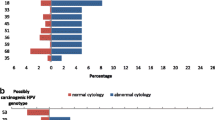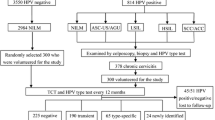Abstract
Objective
To identify the role of Interleukin-6, IL-10 and their epidemiological association in women with persistence of DNA-HPV.
Design and methods
A nested case–control study within a longitudinal cohort study. Cervical specimens and blood samples were collected at enrolment from asymptomatic women who looked for a service of public health in a district of Porto Alegre, Brazil. A logistic regression analysis was performed with 95% confidence intervals. The outcome was the persistence of DNA-HPV infection.
Results
The analysis showed that the age of the first intercourse below 20 years old (OR = 19.65, IC 95% 2.43–68.85), four or more sexual partners during lifetime (OR = 5.67, IC 95% 1.28–24.99), women with a previous altered Pap smear (OR = 10.17, IC 95% 1.80–57.33), marital status (OR = 12.94, IC 95% 2.43–68.85) and IL6 ≤ 3.106 pg/ml were associated with persistence of HPV infection. IL-10 were not associated with the HPV persistence.
Conclusion
The present study suggests that IL-6 levels may be a marker of HPV DNA persistence, although further investigation is necessary.
Similar content being viewed by others
References
Kjaer SK, Chackerian B, van den Brule AJ, Svare EI, Paull G, Walbomers JM, Schiller JT, Bock JE, Sherman ME, Lowy DR, Meijer CLM (2001) High-risk human papillomavirus is sexually transmitted: evidence from a follow-up study of virgins starting sexual activity (intercourse). Cancer Epidemiol Biomarkers 10(2):101–106
Walboomers JM, Jacobs MV, Manos MM, Bosch FX, Kummer JA, Shah KV, Snijders PJF, Peto J, Meijer CJLM, Nuños N (1999) Human papillomavirus is a necessary cause of invasive cervical cancer worldwide. J Pathol 189(1):12–19
Helmerhorst TJM, Meijer CJLM (2002) Cervical cancer should be considered as a rare complication of oncogenic HPV infection rather than a STD. Int J Gynecol Cancer 12(3):235–236
Wu T-C, Kurman RJ (1997) Analysis of cytokine profiles in patients with human papillomavirus-associated neoplasms. J Natl Cancer Inst 89(3):185–187
Koshiol J, Lindsay L, Pimenta JM, Poole C, Jenkins D, Smith JS (2008) Persistent human papillomavirus infection and cervical neoplasia: a systematic review and meta-analysis. Am J Epidemiol 168(2):123–137
Nobbenhuis MA, Helmerhorst TJ, van den Brule AJ, Rozendaal L, Voorhorst FJ, Bezemer PD, Verheijen RHM, Meijer CJLM (2001) Cytological regression and clearance of high-risk human papillomavirus in women with an abnormal cervical smear. Lancet 358(9295):1782–1783
Woodman CB, Collins SI, Young LS (2007) The natural history of cervical HPV infection: unresolved issues. Nat Rev Cancer 7:11–22
Spellberg B, Edwards JE Jr (2001) Type 1/type 2 immunity in infectious diseases. Clin Infect Diseases 32(1):76–102
Clerici M, Shearer GM, Clerici E (1998) Cytokine dysregulation in invasive cervical carcinoma and other human neoplasias: time to consider the TH1/TH2 paradigm. J Natl Cancer Inst 90:261–263
Lubin JH, Gai MH (1984) Biased selection of controls for case–control analyses of cohort studies. Biometrics 40:63–75
Pang D (1999) A relative power table for nested matched case–control studies. Occup Environ Med 56:67–69
Bauer HM, Hildesheim A, Schiffman MH, Glass AG, Rush BB, Scott DR, Cadell DM, Kurman RJ, Manos MM (1993) Determinants of genital human papillomavirus infection in low-risk women in Portland, Oregon. Sex Transm Dis 20(5):274–278
Coutlee F, Gravitt P, Kornegay J, Hankins C, Richardson H, Lapointe N, Vover H, Franco E (2002) Use of PGMY primers in L1 consensus PCR improves detection of human papillomavirus DNA in genital samples. J Clin Microbiol 40(3):902–907
Hosmer DW, Lemeshow S (1989) Applied logistic regression, 2nd edn. Wiley, New York
Liaw KL, Hildesheim A, Burk RD, Gravitt P, Wacholder S, Manos MM, Scott DR, Sherman ME, Kurman RJ, Glass AG, Anderson SM, Schiffman M (2001) A prospective study of human papillomavirus (HPV) type 16 DNA detection by polymerase chain reaction and its association with acquisition and persistence of other HPV types. J Infect Dis 183:8–15
Schlecht NF, Kulaga S, Robitaille J, Ferreira S, Santos M, Miyamura RA, Duarte-Franco E, Rohan TE, Ferenczy A, Villa LL, Franco EL (2001) Persistent human papillomavirus infection as a predictor of cervical intraepithelial neoplasia. JAMA 286:3106–3114
Schiffman M, Herrero R, Desalle R, Hildesheim A, Wacholder S, Rodriguez AC, Bratti MC, Sherman ME, Morales J, Guillen D, Alfaro M, Hutchinson M, Wright TC, Solomon D, Chen Z, Schusseler J, Castle PE, Burk RD (2005) The carcinogenicity of human papillomavirus types reflects viral evolution. Virology 337:76–84
Kemp TJ, Hildesheim A, García-Piñeres A, Williams MC, Shearer GM, Rodriguez AC, Schiffman M, Burk R, Freer E, Bonilla J, Herrero R, Pinto LA (2010) Elevated systemic levels of inflammatory cytokines in older women with persistent cervical human papillomavirus infection. Cancer Epidemiol Biomarkers Prev 19:1954–1959
Carrington M, Wang S, Martin MP, Gao X, Schiffman M, Cheng J, Herrero R, Rodrguez AC, Kurman R, Mortel R, Schwartz P, Glass A, Hildesheim A (2005) Hierarchy of resistance to cervical neoplasia mediated by combinations of killer immunoglobulin-like receptor and human leukocyte antigen loci. J Exp Med 201:1069–1075
Song SH, Lee JK, Lee NW, Saw HS, Kang JS, Lee KW (2008) Interferon-gamma (IFN-gamma): a possible prognostic marker for clearance of high-risk human papillomavirus (HPV). Gynecol Oncol 108(3):543–548
Azar KK, Tani M, Yasuda H, Sakai A, Inoue M, Sasagawa T (2004) Increased secretion patterns of interleukin-10 and tumor necrosis factor-alpha in cervical squamous intraepithelial lesions. Hum Pathol 35(11):1376–1384
Branca M, Garbuglia AR, Benedetto A, Cappiello T, Leoncini L, Migliore G, Agarossi A, Syrjanen K, Collaborative Study Group DIANAIDS (2003) Factors predicting the persistence of genital human papillomavirus infections and PAP smear abnormality in HIV-positive and HIV-negative women during prospective follow-up. Int J STD AIDS 14(6):417–425
Stanczuk GA, Sibanda EN, Perrey C, Chirara M, Pravica V, Hutchinson IV, Tswana SA (2001) Cancer of the uterine cervix may be significantly associated with a gene polymorphism coding for increased IL-10 production. Int J Cancer 94(6):792–794
Wei LH, Kuo ML, Chen CA, Chou CH, Lai KB, Lee CN, Hsieh CY (2003) Interleukin-6 promotes cervical tumor growth by VEGF-dependent angiogenesis via a STAT3 pathway. Oncogene 22(10):1517–1527
Lee SJ, Cho YS, Cho MC, Shim JH, Lee KA, Ko KK, Choe YK, Park SN, Hoshino T, Kim S, Dinarello CA, Yoon DY (2001) Both E6 and E7 oncoproteins of human papillomavirus 16 inhibit IL-18-induced IFN-γ production in human peripheral blood mononuclear and NK cells. J Immunol 167:497–504
Crowley-Nowick PA, Ellenberg JH, Vermund SH, Douglas SD, Holland CA, Moscicki AB (2000) Cytokine profile in genital tract secretions from female adolescents: impact of human immunodeficiency virus, human papillomavirus, and other sexually transmitted pathogens. J Infect Dis 181:939–945
Hong JH, Kim MK, Lee IH, Kim TJ, Kwak SH, Song SH, Lee JK (2010) Association between serum cytokine profiles and clearance or persistence of high-risk human papillomavirus infection: a prospective study. Int J Gynecol Cancer 20(6):1011–1016
Yang R, Murillo FM, Delannoy MJ, Blosser RL, Yutzy WH, Uematsu S, Takeda K, Akira S, Viscidi RP, Roden RB (2005) B lymphocyte activation by human papillomavirus-like particles directly induces Ig class switch recombination via TLR4-MyD88. Immunol 174(12):7912–7919
Koutsky LA, Holmes KK, Critchlow CW, Stevens CE, Paavonen J, Beckmann AM, DeRouen TA, Galloway DA, Vernon D, Kiviat ND (1992) A cohort study of the risk of intraepithelial neoplasia grade 2 or 3 in relation to papillomavirus infection. N Engl J Med 327:1272–1278
Evander M, Edlund K, Gustafsson A, Jonsson M, Karlsson R, Rylander E, Wadell G (1995) Human papillomavirus infection is transient in young women: a population-based cohort study. J Infect Dis 171:1026–1030
Chan JK, Monk BJ, Brewer C, Keefe KA, Osann K, McMeekin S, Rose GS, Youssef M, Wilczynski Meyskens FL, Berman ML (2003) HPV infection and number of lifetime sexual partners are strong predictors for ‘natural’ regression of CIN 2 and 3. Br J Cancer 89(6):1062–1066
Franco EL, Duarte-Franco E, Ferenczy A (2001) Cervical câncer: epidemiology, prevention and the role of human papillomavirus infection. CMAJ 164(7):1017–1025
Bollmann R, Méhes G, Torka R, Speich N, Schmitt C, Bollmann M (2003) Determination of features indicating progression in atypical squamous cells with undetermined significance: human papillomavirus typing and DNA ploidy analysis from liquid-based cytologic samples. Cancer 25 99(2):113–117
Acknowledgments
This research was funded by the National Council of Scientific and Technological Development (CNPq), Brazil; MC Bozzetti is a recipient of a research award from the CNPq.
Conflict of interest
None.
Author information
Authors and Affiliations
Corresponding author
Rights and permissions
About this article
Cite this article
Rosa, M.I., Moraes, M.V., Vuolo, F. et al. Association of interleukin-6 in women with persistence of DNA-HPV: a nested case–control study. Arch Gynecol Obstet 285, 143–148 (2012). https://doi.org/10.1007/s00404-011-1925-7
Received:
Accepted:
Published:
Issue Date:
DOI: https://doi.org/10.1007/s00404-011-1925-7




